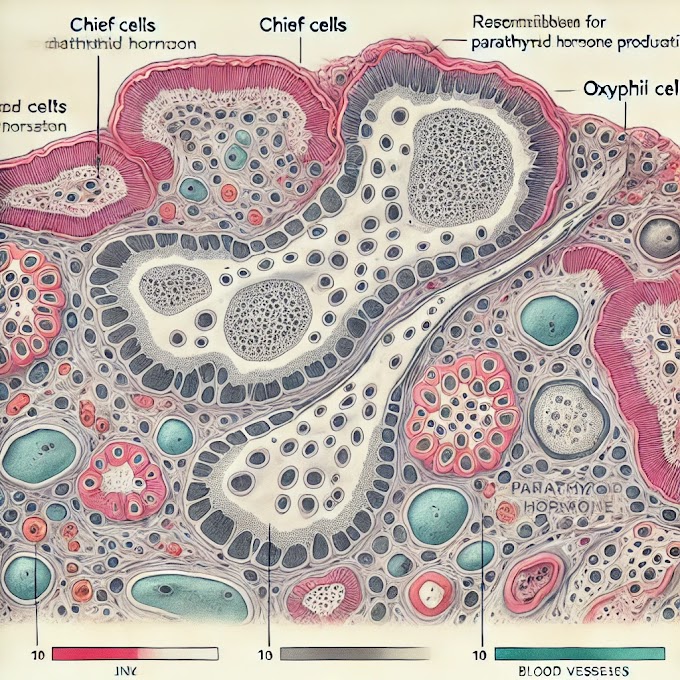Under The Light Microscopic Veiw Stomach All Regin
Identifying histological features of the pyloric, cardiac, and fundic regions of the stomach under a light microscope involves observing specific structural characteristics that differentiate these regions. Here are key points to consider for each:
1. Pyloric Region:
Gastric Glands: Look for numerous mucous cells and some parietal cells.
Pits (Foveolae): These are relatively deep, with glands composed mainly of mucous cells.
Muscularis Mucosae: Typically, thinner compared to other regions of the stomach.
Muscularis Externa: Observe a thick layer of smooth muscle cells forming the pyloric sphincter.
2. Cardiac Region:
Gastric Glands: Fewer and shorter glands compared to the pyloric region, mainly composed of mucous cells.
Pits (Foveolae): Shallow pits with mostly mucous cells.
Muscularis Mucosae: Thicker than in the pyloric region.
Muscularis Externa: Smooth muscle layer forming the cardiac sphincter.
3. Fundic Region:
Gastric Glands: Predominantly composed of parietal cells (for acid secretion) and chief cells (for pepsinogen secretion).
Pits (Foveolae): Deeper pits compared to the cardiac region.
Muscularis Mucosae: Typically, thicker than in the cardiac region, with more pronounced folding.
Muscularis Externa: Thick smooth muscle layer to facilitate mechanical churning and mixing of gastric contents.
When examining these regions under a light microscope, use staining techniques such as Hematoxylin and Eosin (H&E) to highlight cellular structures and tissue organization.
Pay attention to the following features:
Cell Types: Identify different types of cells within the gastric glands (e.g., mucous cells, parietal cells, chief cells).
Glandular Organization: Note the arrangement and density of glands within the mucosa.
Mucosal Thickness: Compare the thickness of the mucosa and muscular layers across different regions.
Vascularization: Observe blood vessels within the submucosa and muscular layers.
By focusing on these histological details, you'll be able to differentiate between the pyloric, cardiac, and fundic regions of the stomach when examining slides under a light microscope.
overview of the anatomy, physiology, histopathology, and clinical significance of the stomach, focusing on its different regions: cardiac, fundic, and pyloric.
Anatomy of the Stomach
The stomach is a muscular, hollow organ in the upper abdomen, part of the digestive tract between the esophagus and small intestine. It is divided into four main anatomical regions:
- Cardia: The area where the esophagus connects to the stomach, leading food into the stomach.
- Fundus: The dome-shaped upper portion, located to the left of the cardia, primarily involved in storing undigested food and releasing gases.
- Body: The largest region of the stomach, containing specialized cells for digestive functions.
- Pylorus: The lower section, divided into antrum and pyloric canal, that leads to the small intestine. It regulates the passage of partially digested food (chyme) through the pyloric sphincter.
Physiology of the Stomach
The stomach performs several essential functions in digestion, including:
- Food Storage: Temporarily holds food after ingestion.
- Mechanical Digestion: Strong muscular contractions mix and churn food with digestive juices.
- Chemical Digestion: Secretes hydrochloric acid (HCl) and enzymes, like pepsin, that break down proteins.
- Protective Role: Produces mucus to protect stomach lining from acidic conditions.
- Regulation of Gastric Emptying: Controls the rate at which food passes into the small intestine for further digestion.
Histology of Stomach Regions
Each stomach region has unique histological characteristics that reflect its function:
- Cardiac Region:
- Contains mostly mucous-secreting cells, forming shorter gastric pits.
- The main function is protective, guarding against acid reflux from the stomach into the esophagus.
- Fundic (Gastric) Region:
- Has well-developed gastric glands with parietal cells (secreting HCl) and chief cells (producing pepsinogen).
- Also contains mucous cells and enteroendocrine cells.
- This region is critical for protein digestion and producing intrinsic factor, which is essential for vitamin B12 absorption.
- Pyloric Region:
- Contains deeper pits with mucous cells that protect the stomach lining.
- Endocrine cells, such as G-cells, secrete gastrin, a hormone that stimulates acid production in the stomach.
- Regulates food passage to the duodenum, preparing it for further digestion in the intestines.
Histopathology of the Stomach
Histopathological analysis of stomach tissue can reveal various diseases, including:
- Gastritis: Inflammation of the stomach lining, often caused by H. pylori infection, excessive alcohol, or NSAIDs.
- Peptic Ulcers: Sores in the stomach lining or the initial portion of the small intestine, often due to H. pylori or overuse of NSAIDs.
- Gastric Cancer: Commonly arises in the stomach's body or antrum. Histological types include adenocarcinoma, lymphoma, and neuroendocrine tumors.
- Atrophic Gastritis: Chronic inflammation leading to the loss of gastric gland cells, which can reduce stomach acid production and lead to nutrient malabsorption.
Clinical Significance of the Stomach Regions
- Cardiac Region: Issues in this region can lead to gastroesophageal reflux disease (GERD), where stomach contents back up into the esophagus, causing symptoms like heartburn.
- Fundic Region: Malfunction in acid-producing cells here can result in hypo- or hyperacidity, impacting digestion. Chronic conditions affecting the fundic glands can lead to B12 deficiency due to a lack of intrinsic factor, resulting in pernicious anemia.
- Pyloric Region: Dysfunction here can cause delayed gastric emptying (gastroparesis) or pyloric stenosis, particularly in infants. Disorders in this region also affect gastrin secretion, leading to conditions like Zollinger-Ellison syndrome, characterized by excessive acid production and ulcer formation.
Conclusion
The stomach's anatomy, histology, and physiology make it central to digestive health. The distinct features of each stomach region allow for specialization in protection, digestion, and hormone regulation. Identifying changes in histopathology of these regions can aid in diagnosing conditions ranging from gastritis to cancer, emphasizing the importance of stomach health in overall well-being.
Click here to youtube channel Ikrambaig@Tech For video
















0 Comments